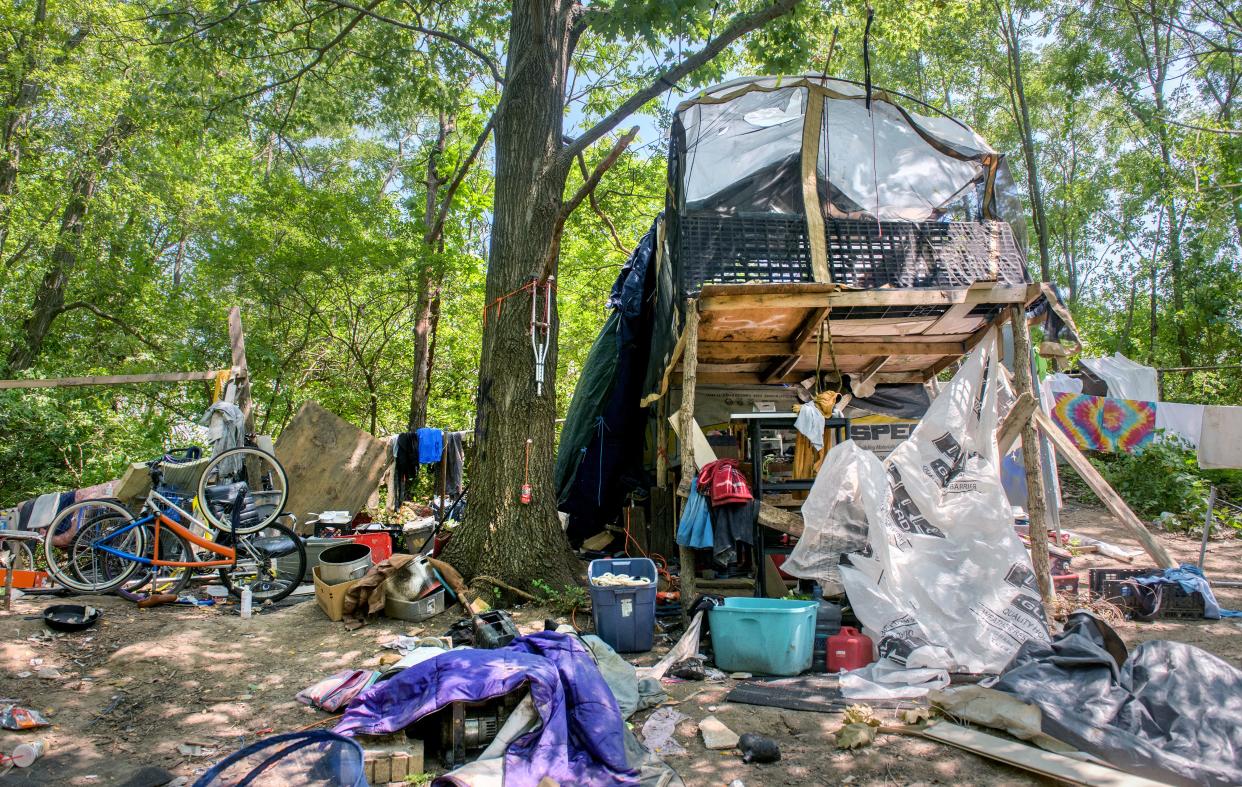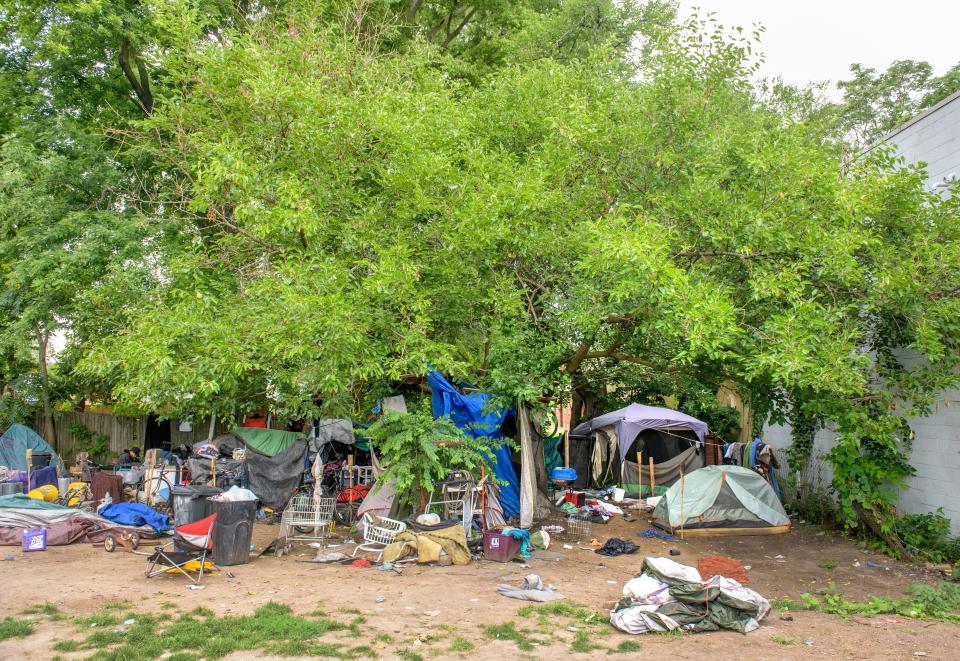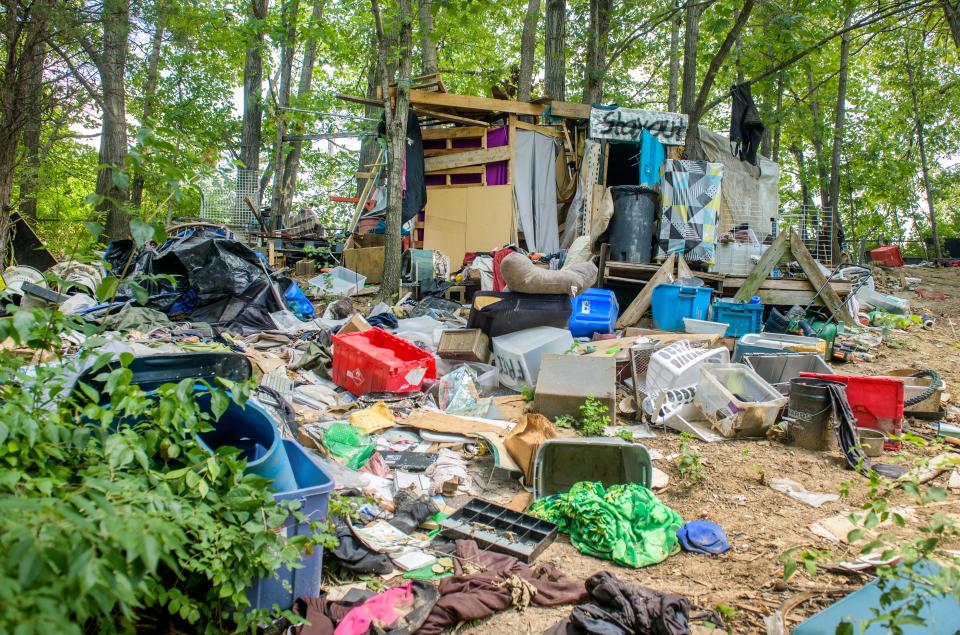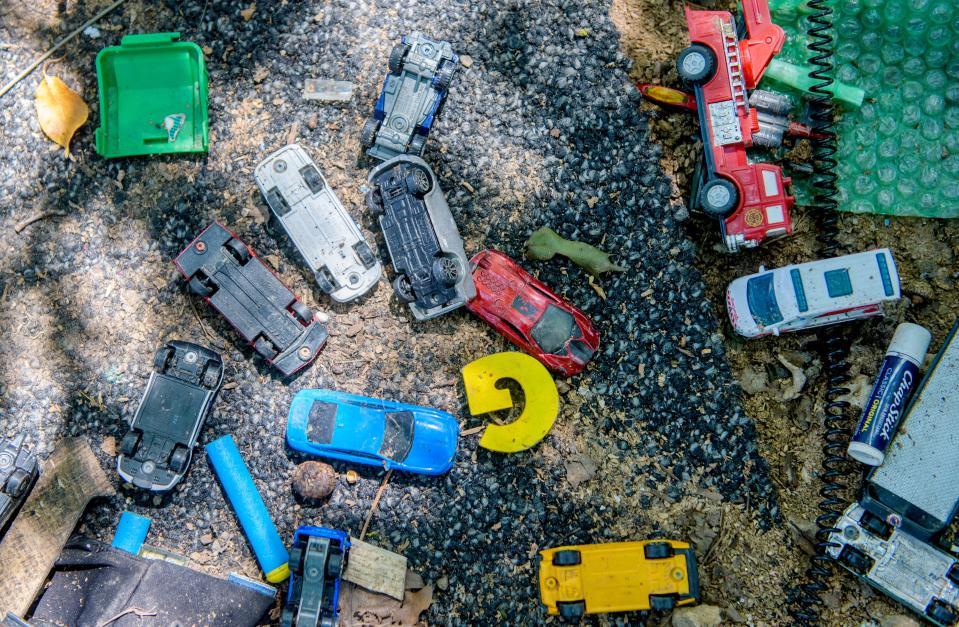'Survival mode': A look at Peoria's homeless camps and the community effort to help them

Tucked away just off Knoxville Avenue in Peoria, a transient group of 20 to 25 has made an empty plot of land its temporary home.
This makeshift community is a cluster of tents and shelters pieced together with dirty blankets, boxes, tarps and anything else that can be scavenged to protect them from the elements. Garbage and junk are also fixtures at the camp, where sanitation has become a chief concern for city officials.
Across town, hidden in a thick, wooded area and nestled between Dries Lane and Interstate 74, another encampment can be found. This one, unlike the Knoxville Avenue encampment, is a sprawling camp, covering multiple acres of land, virtually hidden from the public eye.
The shelters at the Dries Lane camp, which houses about five people, are more sophisticated and pieced together with a hodgepodge of discarded building materials. The camp has actual structures, built by hand, and some have doors and rooms. One is even a loft.
Drug use is commonplace at the Knoxville Avenue camp, residents say. Particularly in recent years, heroin and opioid addiction have ravaged the Peoria homeless community.
Living in Peoria for three decades now, Brent Watts says he has stayed at the Knoxville and Dries Lane camps in recent years while battling addictions to crack cocaine and heroin. Life in the camps is hard, he says, but it's better than being alone.
Battling addiction and homelessness is a brutal game, but when surrounded by others facing the same plight, there is some comfort.
"Our feelings are irrelevant. We're not afforded the levity of feelings. Our feelings are, we're surviving," Watts told the Journal Star. "This here is a representation of the epidemic of opioids. We are counted as discarded members of society who are whisked and put away somewhere not seen."
At these camps, the reality of homelessness and those living in "survival mode" is crystal clear. Piles and piles of garbage litter the camp, evidence of the struggle its residents deal with every day.
These are two of Peoria's homeless encampments. And although they are residence to just a fraction of Peoria's homeless population, they serve as harrowing reminders of the unhoused.
Location of Peoria's homeless encampments creates complicated issue

Both of Peoria's homeless encampments are located on Illinois Department of Transportation land, and for strategic reasons: The residents know they are not likely to be removed by the state.
"It definitely complicates the situation, specifically for the city," said Kate Green, the executive director of United Way's Continuum of Care. "I will absolutely admit that from my perspective, I have more to gain from addressing the needs of those experiencing homelessness, and the city has all kinds of different needs coming to their attention. Whether that be property owners in close proximity, business owners, public health concerns, you name it, there's other challenges they're navigating."
Green said the city of Peoria remains a strong partner with the Continuum of Care, but in the case of Peoria's homeless encampments, there are different challenges between the parties. Green said Continuum of Care will always advocate for not displacing people at camps because it can disrupt trust and "continuity."
"Every time the system comes in and does things like the forced moves or impacts their belongings or where they call home, that distrustful nature just compounds itself," Green said.
More: 'They hate me that much?': Panhandlers in Peoria say they face mistreatment
Watts said he and other residents have a constant fear of being removed from what they call their home. But they are aware of the camp being on state land, a fact that comforts them.
Without the camps, they ask and worry, where else are they supposed to go?
"We're just trying to survive with addiction," Watts said. "There's not enough beds in rehab, there's not enough spaces in the hospital. The criteria for detox ... unless you're currently using drugs, you can't get into detox. If you were to not have used drugs for a few days, you aren't eligible for the programs. The only doorway to get into an immediate recovery or help situation is to go through the emergency room."
Continuum of Care has worked with Christine Haley, the state homelessness chief, and has advocated that the state not remove people from the camps on IDOT land.
Joe Dulin, the community development director for Peoria, said the city's relationship with outreach groups such as Continuum of Care and Phoenix Community Development Services is strong, but said the city has a difficult task of balancing compassion with public health and safety.
"It's a tough balance for city government, especially with the encampments, specifically on IDOT property, who have to make the decision if they're allowing them or not allowing them because they're the ones who have the authority to deal with that," Dulin said. "The city's approach is to be respectful of the neighborhoods and to allow our nonprofit partners to do their work to provide services and engage residents who are willing to engage."

The city has invested between $13,000 and $15,000 this year on cleaning up at the encampments, Dulin said, but given they are on IDOT land, there is not much the city government can do.
Dulin said the city's preference for the encampments would be for all their residents to end up in shelters. He said the city has seen success stories in the past. In the spring, the city worked with nonprofit groups to clean up a homeless encampment near I-74 in downtown Peoria, across from the Mark Twain Hotel.
He also said as Peoria continues to address a need for more affordable housing, like it is doing with projects in South Peoria and downtown, the issue of homelessness will lessen.
"That's the goal for every agency and everyone involved: The more affordable housing you can provide for our residents, the issue gets addressed," Dulin said. "That is what we will continue to look at and advocate for, is more affordable housing opportunities so those that are experiencing homelessness have a roof, have a place to go, because that is the cleanest and safest place for them as well."
The Peoria Police Department has a camera monitoring the Knoxville Avenue location. Police spokesperson Semone Roth said the camera was not placed there specifically because of the camp, but it is there so police would be aware of any safety concern should it arise.
Watts said his question for the city would be this: "OK, we'll leave. Where would you like us to go?"
How do homeless encampments come to be?

What causes homelessness can be hard to pinpoint because it can vary drastically on a case-by-case basis. But one thing is clear — the path into homelessness is much shorter and easier to take than the path out.
"We're all just one bad decision away from being in a situation that is probably very similar," said Tracia Hammer, a homelessness outreach worker. "Just remember they are human beings and they are just in a different state than we are with jobs and houses."
Substance abuse is an issue among the homeless, but not to the extent most people assume it is, said Chris Schaffner, the director of JOLT Harm Reduction Services in Peoria. He said substance abuse problems are only found in "30-40%" of cases among homeless people in Peoria.
"There isn't just one easy definition or description of what it means to be homeless in Peoria. There's so many factors," Schaffner said. "Each person has their own unique story that led them to that place."
More: A harm reduction group once stirred controversy in Peoria. Now, its expansion is welcomed
Despite the obvious challenges, living in an encampment offers people experiencing homelessness a sense of community. On the streets, people find themselves in "survival mode." A sense of community can offer comfort.
"Not only is it a safety in numbers, but most of the folks experiencing homelessness, maybe their families aren't around or they don't have family anymore and really what they become is what they call a 'street family,'" said Molly Pilgreen, the COO of Phoenix outreach services. "So really what they become is a family. That is their life. Those are their people and they protect one another and care deeply about each other."
Watts said even when he does have money for a hotel room or access to a shelter, he'd rather be in the homeless camps with "his people."
"I happen to have a pocket full of money and my drug, a hotel room, but I would rather be right here sitting amongst my people," Watts said. "We aren't criminals doing things to support our addiction. We're addicts who end up being forced to have criminal behavior because society doesn't want to see us."
The populations of Peoria's homeless encampments can often change as those living at them become sheltered or work their way out of homelessness. With each change of population within a camp, safety dynamics, camp rules and lifestyle can change as well.
In some cases, de facto leaders have emerged at camps. A constant changing of the faces around you is just a part of the ebb and flow of living in a homeless encampment.
"We're actually experiencing some of that right now at both of the encampments. Some key people have been housed, some went through treatment and got sober, some moved out of those places," Schaffner said. "And so there are some new faces that have moved into those spaces, and it has changed the culture."
The urgency to shelter people experiencing homelessness grows when winter approaches and temperatures drop to dangerous levels. During those times, residents of the encampments will sometimes all pile into one tent to keep warm.
Phoenix estimated there are roughly 400 to 450 homeless people in Peoria. Continuum of Care says it has served 122 people this year.
Summer is a time of high census numbers at Peoria's homeless encampments.
"The culture and environment of encampments are constantly evolving and changing based upon lots of things; even the time of year and weather can make an impact," Green said. "This time of year is typically when we see a concentration of folks experiencing unsheltered homelessness and you might see signs, whether it's tents or encampments."
What is being done to aid Peoria's homeless camps?
Getting someone out of homelessness is a steep uphill battle for both the homeless person and aid workers.
A common criticism aid workers say they hear of homeless people is, "Why don't they just get a job?" It's a perhaps fair question to ask if one were to look at the multitude of job openings in Peoria and compare that with the number of homeless people.
But the answer is far from that simple, and the path to getting a homeless person sheltered and employed is long and complicated.
In many cases, outreach workers say, people experiencing homelessness often do not have identification, copies of their birth certificate, Social Security cards, phone numbers, access to email, printed resumes, access to online job listings or mailing addresses. Those things are crucial to securing employment.
Couple those factors with an inability to shower, shave and wash their clothes, and you have a poor recipe for getting a job.
"When anybody is going out to look for a job, that is a long-term solution — that is something stable and permanent you are hoping to retain far into the future," Green said. "For folks who find themselves experiencing homelessness who don't know where they are going to put their head at night, where their next meal is coming from, the idea of gaining employment in the first place is very difficult."
More: 'Stabilize the neighborhood': How one effort led to investments in Peoria's East Bluff
Securing immediate needs such as food, shelter and water are often top of mind for homeless people in their daily life. Finding employment and permanent housing is ancillary.
Watts said the food pantries "help a lot" and aid from JOLT, such as blood pathogen testing and the handing out of clean needles, is a life-saving service for people in the camps.
"The numbers on their results are astronomical to success in saving lives because their goal is reduction of harm," Watts said of JOLT. "When they hand out clean needles and test strips and give out food and water and things of that nature, that is literally a change that is an immediate change that helps."
Heroin and opioid overdoses are a particularly frightening reality in the camps. Watts said it is the type of thing camp residents might see every day in Peoria.
Outreach groups in Peoria such as Phoenix, Continuum of Care and JOLT work to help homeless people acquire IDs and birth certificates necessary for securing housing and employment. But the process is cumbersome and can take weeks and even months.
"The amount of time my staff and I have spent trying to help someone get an ID is insane," Schaffner said. "You need documents to get other documents, but in order to get that document, you need other documents to get the documents. It's crazy.
"There's a lot of things that go into holding a job that we think — those of us who are privileged enough to have transportation, stable housing and employment — we think is just easy to just get up, pull yourself up by the boot straps and get a job," Schaffner said.
Hygiene is a major challenge for Peoria's homeless population as well, but the aid workers help where they can.
Continuum of Care and Phoenix team up to bring to Peoria's homeless camps the HOWIE, a mobile hygiene unit that can offer a shower, place to shave and washing machines. All are pivotal steps in getting out of homelessness.
"If you've ever gone to an interview without having shaven in 60 days or been able to wash your clothes in the last three or four weeks, or showered in the last three or four weeks, how do you show up in a presentable way that would make an employer want to hire you?" Schaffner said.
Illinois Gov. JB Pritzker signed into law a bill on July 26 that is aimed to bring homelessness in Illinois to "functional zero." The budget passed by lawmakers this year included $350 million to combat homelessness.
"This bill codifies the unprecedented interagency collaboration to move Illinois to 'functional zero' homelessness by bolstering the safety net, targeting high-risk populations, expanding affordable housing, securing financial stability for unhoused individuals, and closing the mortality gap," the Illinois Department of Human Services said in a statement.
IDOT said it is aware of the camps and monitoring the situation.
The State Department of Human Services said in a statement to the Journal Star that they are committed to helping homeless people in Peoria's encampments and others around the state, adding they will continue to work with the Continuum of Care.
As far as what the rest of society can do for help, Schaffner says just giving a little bit of money can help a homeless person get what they need for the day to survive — which can sometimes include drugs or alcohol.
"What most people don't understand is that withdrawals from alcohol, withdrawal from opiates, benzos, withdrawals from a lot of these drugs can be fatal without access to the proper medical detoxification. Going through withdrawals can be miserable in ways the average person without a drug addiction cannot even comprehend and can be fatal," Schaffner said. "I always advocate, give money, who cares, that's between you and yourself. But if you give money, do it with no strings attached and trust they're going to use it on whatever they need to get through that day."
Beyond monetary value, however, treating everyone with dignity is invaluable.
"Check your own heart. It doesn't take anything to smile and be kind to someone you suspect might be homeless or people who are panhandling," Schaffner said. "Just looking someone in the eye can be dignifying."
This article originally appeared on Journal Star: Peoria IL homeless camps highlight struggles with homelessness

